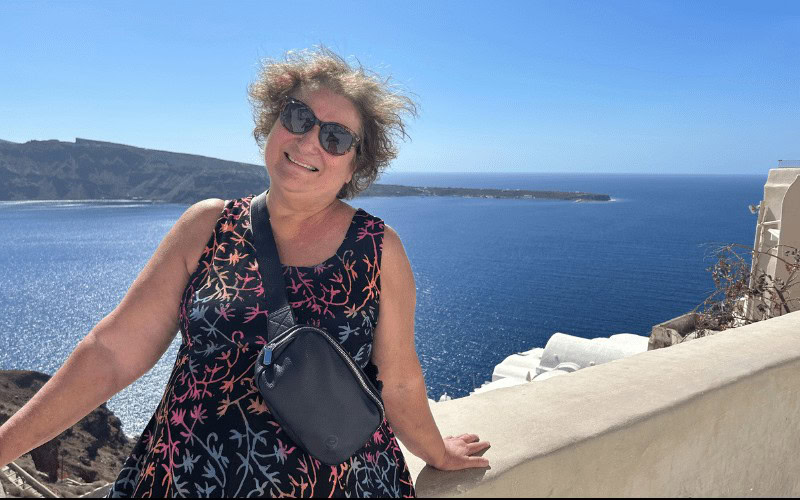Stay in Oia to Enjoy a Stunning Santorini Experience
Staying in Oia is a must-do for the Santorini-bound traveler.
The gorgeous little whitewashed town is one of several that frosts the tops of Santorini’s striated brown and ochre cliffs like plaster beads on a string.
Above is a blue sky occasionally studded with drifting clouds. Below is the deep, deep blue sea. Oia is so breathtakingly beautiful that it doesn’t seem real.

Each time I look out at the view of the caldera, I repeat the phrase the wine-dark seas of Odysseus that I remember reading many decades ago when I studied Homer. And yes, although the sea is blue, “wine-dark” perfectly describes it.
Perhaps because I know the role Greece has played in forming Western civilization or maybe because the Aegean sea really is different, I sense a richness and a depth to the water that is unmatched by any other body of water I’ve seen.
I can easily imagine Greek triremes sailing across sea, the soldiers’ helmets shining in the strong sunlight, spears at the ready.
Santorini At a Glance
- Stay at Aethrio Sunset Village in Oia
- Visit a Santorini winery
- Take a private guided tour around Santorini
- Take a boat tour
- Watch the sunrise in Oia
Overview
People have lived on beautiful Santorini forever—or so our guide tells us during our tour of the island on our second day. And indeed, evidence of human habitation goes way, way back—even to the lost city of Atlantis.
Was Santorini Atlantis? No one knows! But an attraction—to style it a museum is a stretch—called The Lost Atlantis Experience is built around the notion that Santorini and Atlantis are one and the same. More on the Atlantis myth later!
In this post, I chronicle the four nights and three full days I spent on Santorini with my daughter, Julia (read more about Julia and her adventures as a crochet artist here).
Santorini is the first stop on our 13-day whirlwind trip through Greece that includes a week in the Cyclades (Santorini and Naxos) and 8 days exploring the Greek mainland, including Nafplio, Athens, and Meteora.
Map of Santorini: Locations Visited
The map of Santorini below shows the locations I visited. I stayed in the town of Oia (#1), which is at the northern tip of the island about 40 minutes drive from Fira and from the airport.
Click a number to read more about the location.
Arrival
An easy four-hour flight takes us from London Gatwick to Santorini. Our bags are already on the carousel by the time we deplane and go through customs (a very fast process).
We emerge into the arrivals hall to find a driver holding up my name. Private transfers don’t come cheap, but I have to say they are well worth the money.
Twenty-five minutes later, our driver pulls up to the outskirts of little Oia, located on the far northern tip of the arc of Santorini Island.
The main city, Fira, is in the middle, and at the other end is Akrotiri, site of an ancient Minoan city.
Checking In to the Aethrio Sunset Village
Our hotel is the Aethrio Sunset Village, chosen for its location in the center of the network of tiny, cobbled laneways in the heart of Oia and its relatively reasonable (for Santorini) price.
We quickly discovered when looking for accommodations that Santorini is not cheap, at least not if you want to stay in a walkable location, which I recommend you do.
The Aethrio Sunset Village turns out to be an excellent choice. Our air-conditioned little suite includes a small kitchen, a living room and a bedroom, along with a small private courtyard.
It’s the perfect refuge after exploring Oia and the rest of the island in the September heat.
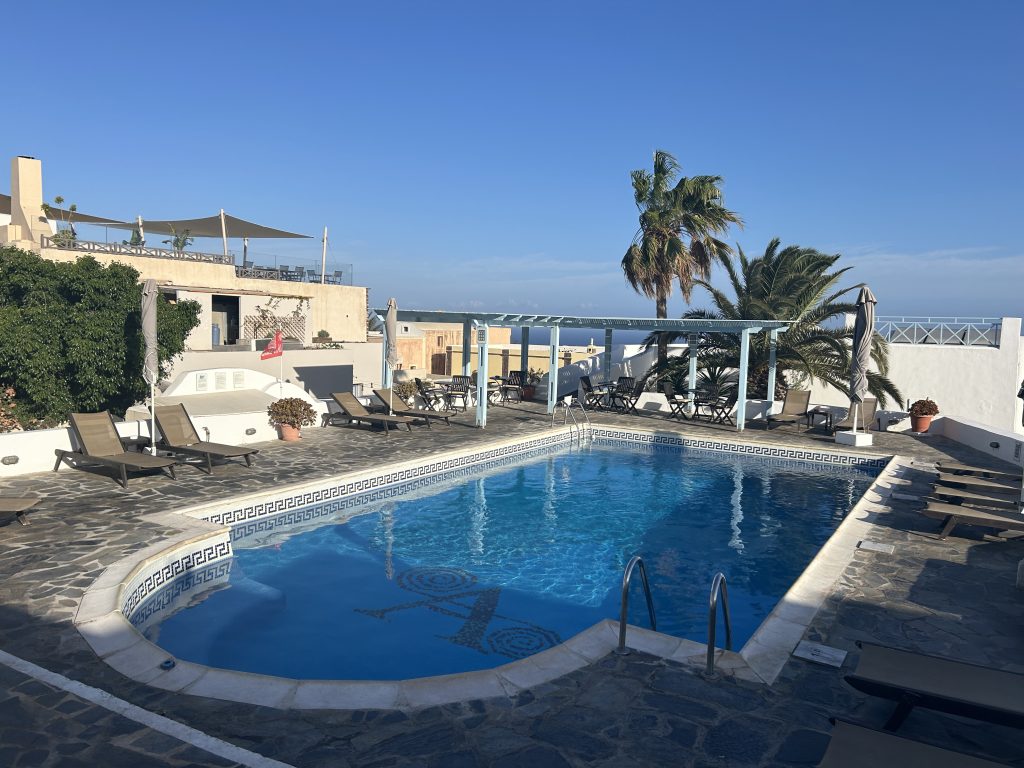
First Exploration of Oia
After getting settled, I go exploring. Julia is not feeling well, so my first stop is the pharmacy.
On the way, I pass shop after shop selling a plethora of intriguing looking souvenirs. I mostly resist, in the hope of finding similar offerings when we go to Athens. I’ve read that the same souvenirs are cheaper in the Athens markets than on the expensive islands of Santorini and Mykonos.
Later, I buy a pendant that the shopkeeper assures me is made by a jeweler on the island and is not found in any other shop.
So far as I can tell after much perusing of the shops, he’s telling the truth. I never see a similar one, whereas several of the designs are ubiquitous.
Crowds in Oia
Oia can be crowded, especially when a lot of cruise ships are anchored out in the caldera, and it is certainly touristy.
Every shop and café caters to visitors; the only locals are those who work in them.
In some ways, the village feels like Oia Land, a sub-land of Santorini Land, but that’s only on the surface.
I’d hate to make the trip to Santorini only for a day because it deserves more time. If at all possible, stay in Santorini for at least three nights.
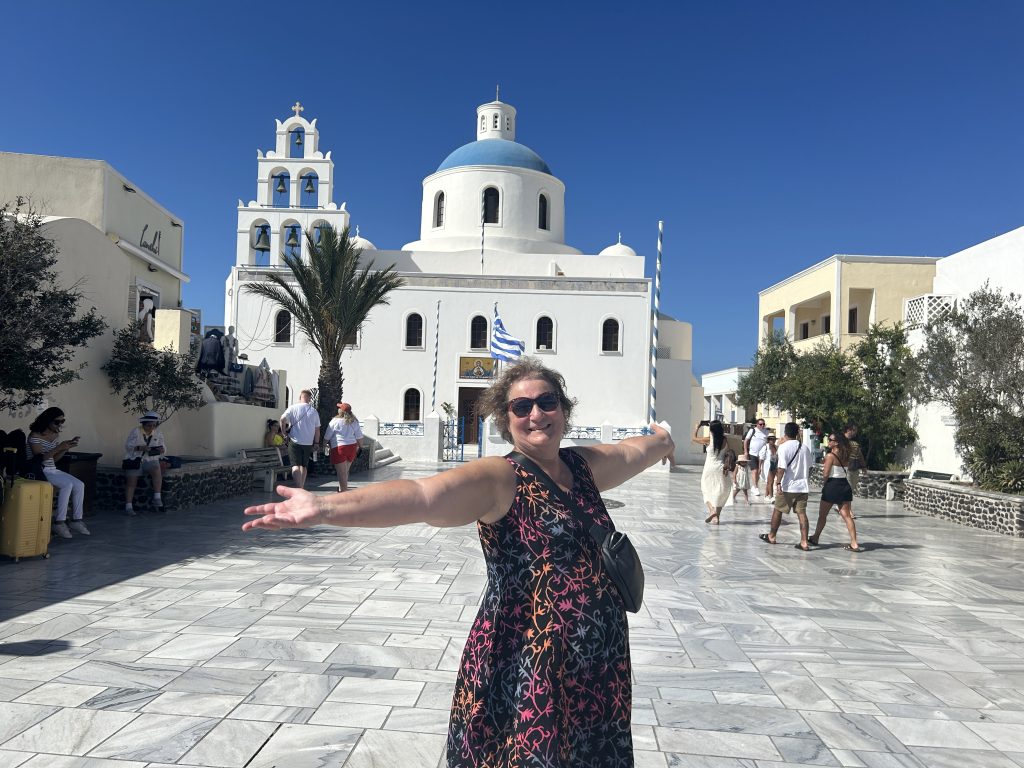
Our First Dinner in Oia
The hotel makes us a reservation for a sunset view table at Kyprida Restaurant so we can watch the sun dip into the Aegean Sea in comfort.
It’s the perfect choice. We enjoy our first Greek meal—chicken souvlaki for Julia and prawns and salad for me.
While we eat, we witness the famous Santorini sunset, which turns out to be one of the most breathtaking sunsets I’ve ever seen—and I live on an island in a house that faces west!



First Full Day in Oia
On our first full day, we decide to lie low. Julia is suffering from jet lag and possibly a cold. At Aethrio Sunset Village, we enjoy our first Greek breakfast of yogurt, honey, and fresh bread (divine).
We then spend the morning doing very little. We’ve booked a boat trip for the afternoon but are able to postpone it until Friday.
Relaxing by the Pool in Oia
For most of the day, we alternate between hanging by the pool and walking around the tiny streets of Oia, snapping endless pictures and checking out the shops.
Yes, it’s touristy, but the views! They really are stunning. Pictures can’t do it justice, although I have probably 100 pictures on my phone to prove that I tried.
There is no vehicular traffic within Oia, making it a very restful place to wander around, particularly when the crowds abate.
Dinner Overlooking the Caldera
In the evening, we dine at Flora Restaurant, which overlooks the caldera.
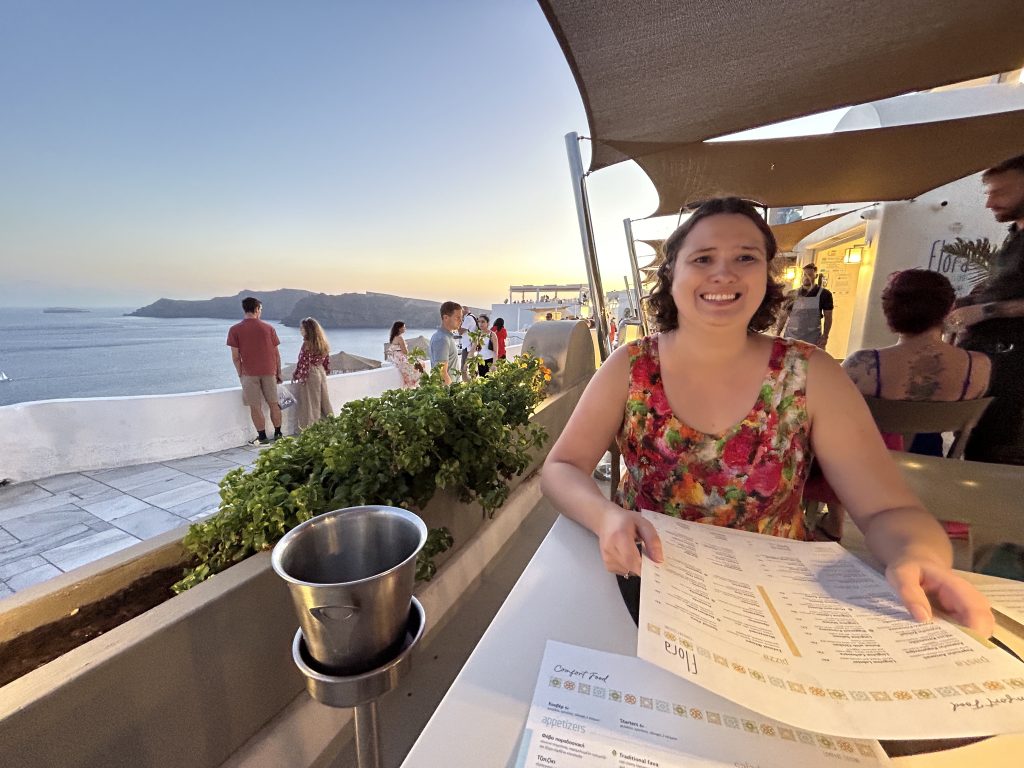
The extremely good-looking Greek waiters are efficient and friendly. Here’s my lamb shank, which the waiter assures me is the best in Oia.
I can’t verify that, but it is extremely tasty!

Over the next few days, we are to discover that the service at the restaurants and cafés of Oia is far superior to what we experience in Fira, the capital of Santorini (AKA Thira) and by far the most crowded place on the island.
NOTE: While visitors refer to the island as Santorini, its real name—and the one locals use—is Thira.
Exploring Santorini on a Private Tour
On Day 2, we planned to take a small group tour of the entire island.
After lunch at yet another caldera-view restaurant with excellent service and terrific traditional Greek food, we meet our guide outside the Hungry Donkey café on the road that skirts Oia.
Private Tour
Our small group tour turns out to be a private tour because another couple canceled. Fine by me! We get a private tour for the price of a small group tour.
Our friendly and very knowledgeable guide tells us we can go and do whatever we wish for the next five hours or follow his itinerary or do a combo of the two.
We choose the latter and ask him to take us to a winery to sample some local wines and then to the Lost Atlantis Experience and end with a view of the sunset. He can fill in the remaining time with whatever he thinks we’ll enjoy.
The five-hour tour is a fabulous way to see a great deal of Santorini in comfort. Here’s an option for a private tour around Santorini:
The Art Winery
Our first stop is the Art Winery, reputed to be the oldest winery on the island. I ask how long wine has been produced on the island.
Forever is the answer. Always forever! This is a very old part of the world in terms of documented human habitation!
The winery doubles as an art gallery. Two large exhibition spaces feature work by local and international artists.
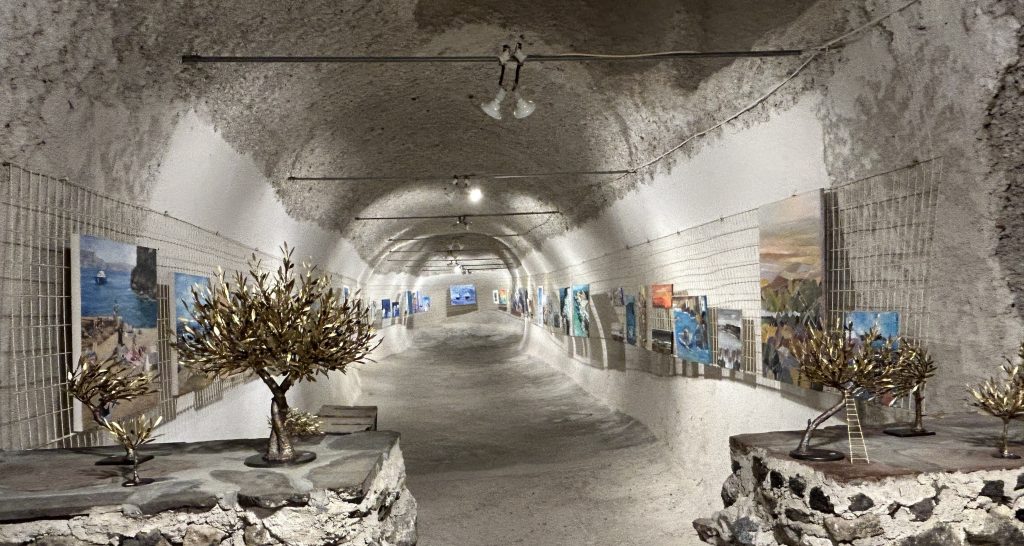
After I snap a few pictures of the artwork, we take a short tour, learn a bit about the production, and finally taste five wines.
All of them are excellent. We’re told that outside of Santorini these wines are prohibitively expensive because so few bottles are produced. Even Gordon Ramsay favors wine from the Art Winery.
I buy a bottle that is packaged for safe transport home in my suitcase. It’s a robust white wine that I’m looking forward to enjoying in the depths of winter in the hope of reviving memories of sun-drenched Santorini.
Highest Point on Santorini
Next is a drive up, up, up to the highest point of the island where a small monastery sells olive oil and other delicacies. Julia buys a bottle, and we admire the stunning views.
Not for the first time since coming to Santorini, I’m glad that I decided not to rent a car. The road to the summit is a series of very steep switchbacks with sheer drops.
With a pro at the wheel, I can relax.
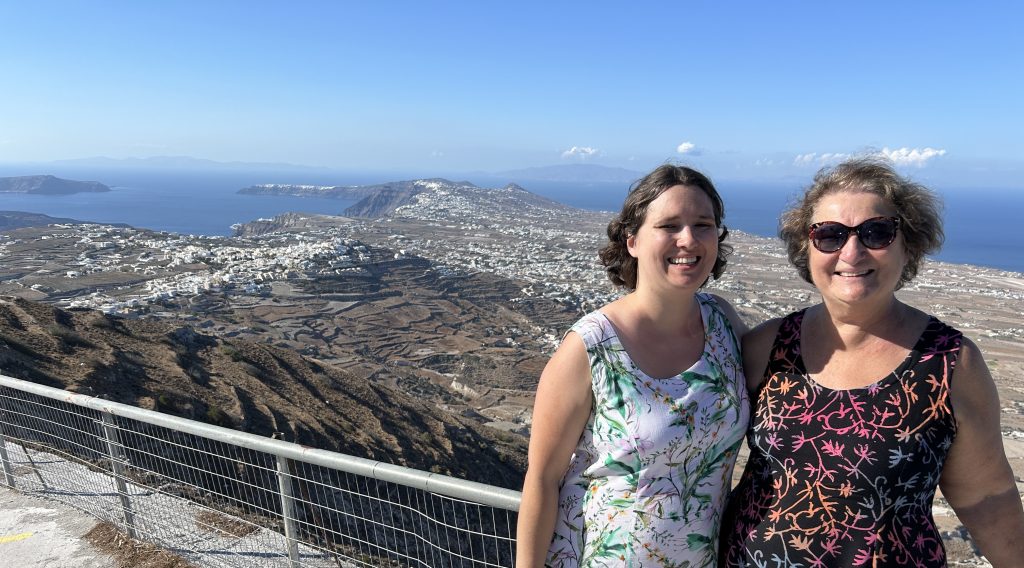
Lost Atlantis Experience
Our guide wants to take us to Red Beach, but we ask to instead to driven to the Lost Atlantis Experience. Big mistake!
I’d thought this would be a Santorini must-see. I am wrong. It’s kind of an Atlantis theme park complete with interactive exhibits featuring Plato discussing Atlantis and an actual theme-park-style ride.
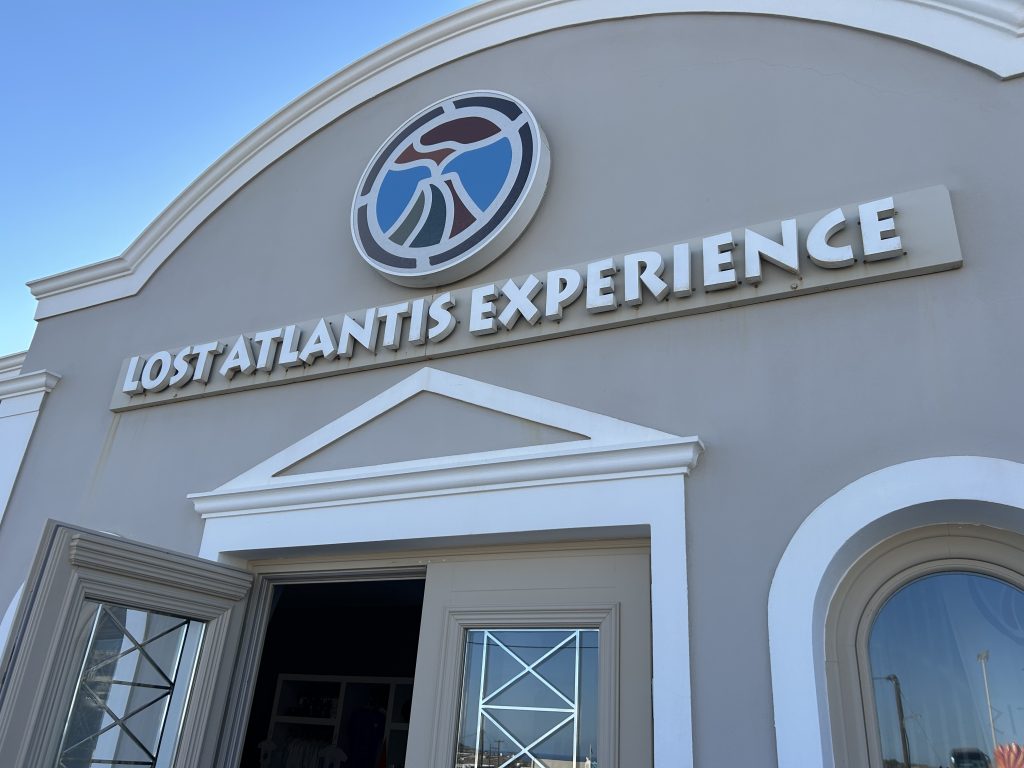
The 9D Experience
Touted as a 9D experience (I didn’t count), the experience consists of being strapped into a seat and given 3D glasses.
The screen comes to life and for about ten excruciating minutes, we’re taken on a virtual roller coaster ride through an ancient civilization that may or may not have been Atlantis, which was then destroyed when the volcano now at the center of the caldera erupted.
Cue many close-up shots of frightened Atlanteans fleeing for their lives, followed by flowing lava and falling rocks punctuated by literal punches in my back from the seat, lots of shaking and shimmying, occasional bursts of water from the seat rests, and the odd blast of cold air that is actually quite welcome.
I don’t taste or smell anything so I’m not sure what is 9D about the experience.
We share our Atlantis experience with a Russian couple who are quite affronted that none of the available languages in the headsets is Russian.
Afterwards, we are ushered through various exhibits by the endearingly earnest staff. There are more staff than visitors during our visit. Hopefully, that’s not always the case since I imagine the ride and exhibits cost a fair bit to maintain.
Should You Go?
The fourteen-euro-per-person charge is steep for what we get. But we gamely watch as many of the screens as we can before finally being released into the gift shop.
I buy an Atlantis mouse pad and Atlantis mug for Gregg who has long been an Atlantis fan. It’s cheesy, but whatever.
I imagine our guide wonders why we want to waste our time and money on the Lost Atlantis Experience, but he is polite enough not to say.
My advice? The Lost Atlantic Experience is not worth a visit unless you’re traveling with children who will probably enjoy the interactive exhibits.
Megalochori
Our guide takes us next to the traditional village of Megalochori, a tranquil place with only a handful of gift shops and some enticing looking restaurants. It feels like a place inhabited by locals.
Our guide (we never did catch his name) takes us into a cave that was inhabited until the 1990s. It’s extremely dank and unpleasant and hard to believe people lived there in modern times.
Of course, now you pay very big euros to stay in a cave in Oia, but I think those caves are quite a bit swankier.
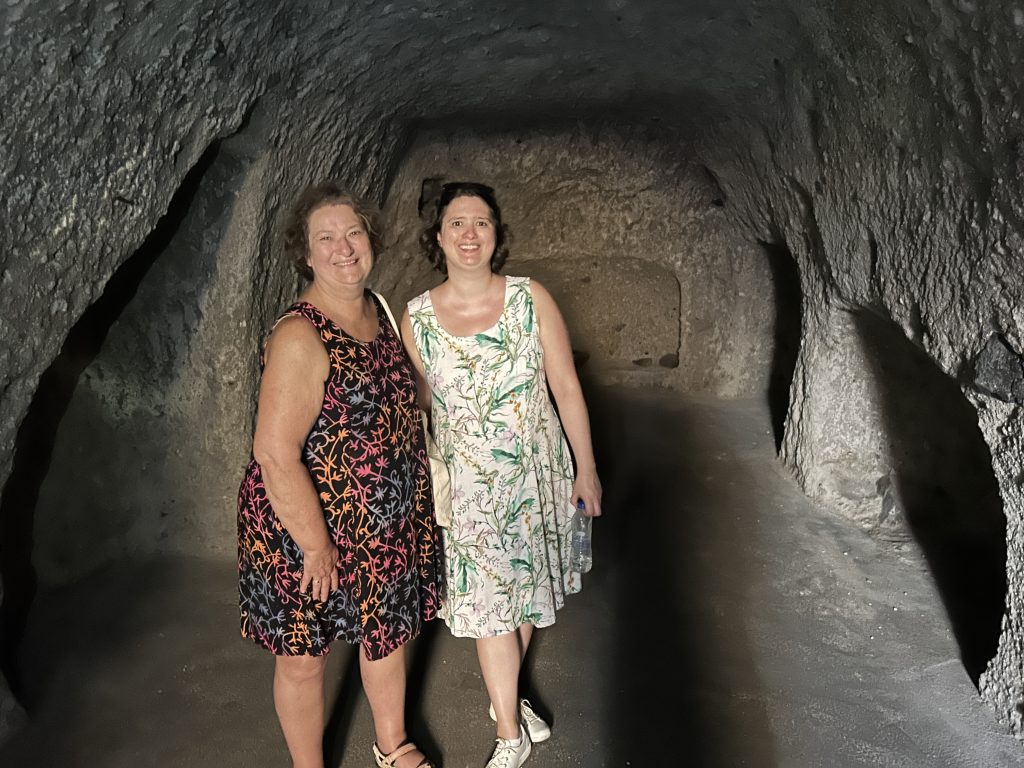
Black Sand Beach
Our guide drives to the south side of the island and along a beautiful stretch of black sand beach. Black sand beaches are found in only a handful of places in the world—Iceland, New Zealand, Hawaii, and Santorini (and now I’ve been to them all!).
Sunset Over Firostefani
Finally, we return to the steep rim of the caldera to wait for the sun to set. Our guide jokes about people flocking to watch something that has happened every day “forever”, but he stands with us, his tanned face a ruddy gold from the sun’s rays.
I ask him if he ever gets tired of the view, and he says never—and he was born and bred on Santorini. He tells us that the island didn’t get electricity until 1971, just a few years before he was born.
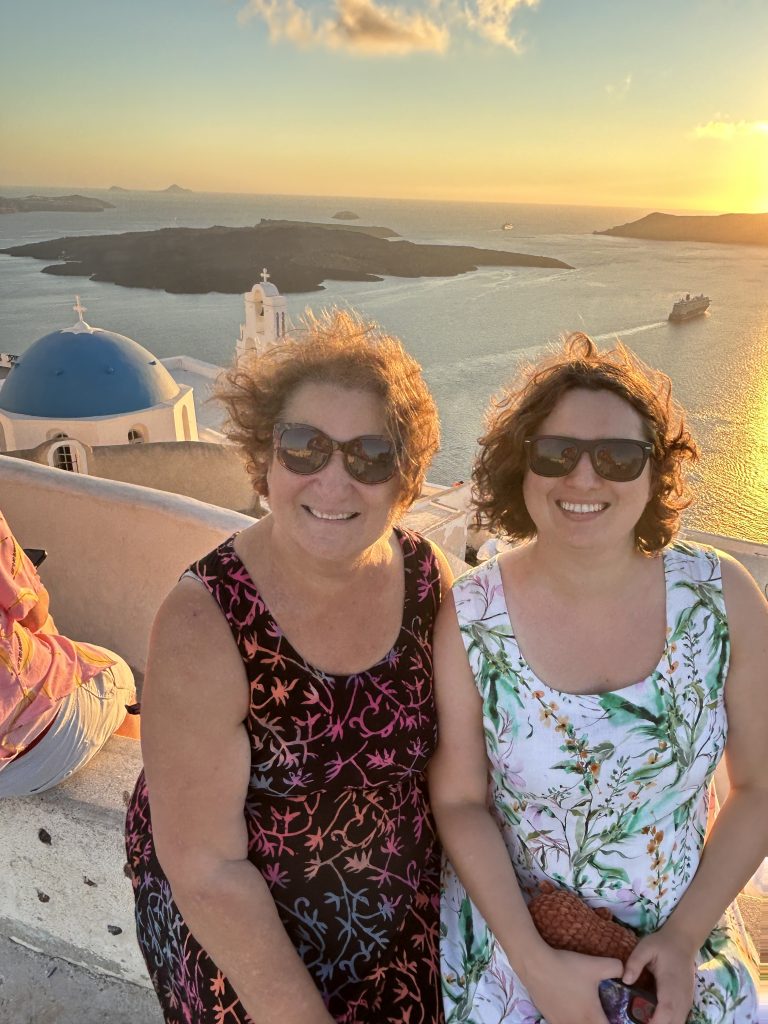
Here’s a video I shot as the sun sets over another lovely day on Santorini.
The Road Back to Oia
After watching the sun disappear into the sea, our guide drives us back to Oia along a cliff-hugging road with views out to the Aegean on both sides.
Magical!
Why Take a Tour of Santorini?
In the over fifty years since the advent of electricity, Santorini has developed into a world-class destination. Our guide tells us that he doesn’t even recognize the island anymore.
Although he makes his living taking tourists around the island, he agrees that there are too many visitors and that reducing the number of ships allowed on any one day would be wise.
I’m glad we’ve driven the length and breadth of the island and seen places that are relatively tranquil.
During the tour, we discover that the back side of Santorini facing in the opposite direction from the caldera is beautiful in a bleak kind of way, but lacks the drama of the caldera-facing views.
The vegetation is sparse, the soil extremely dry, and the architecture not as pristine as that in places such as Oia, which really is postcard perfect.
Here’s a video I shot of the caldera that really shows off the deep blue of the sea.
Final Full Day
Our last full day is a busy one. Since we’ve postponed the boat trip to today, we must combine it with our planned trip to Akrotiri at the far end of the island.
As it turns out, we have plenty of time to do and enjoy both and still squeeze in an excellent lunch at a restaurant overlooking the water in super-busy Fira.
Getting to Akrotiri
We intend to take the public bus—a trip that will require 90 minutes and two buses if we get the connections to sync up.
At the bus station in Oia, I spy a taxi and ask him how much to Akrotiri. He tells me 55 euros. Hmm. Seems steep compared to 4 euros each for two bus trips—Oia to Fira and then from Fira to Akrotiri. I dither.
But the bus doesn’t appear to be coming, and our time is limited.
I shrug and accept the taxi driver’s option, and soon we’re sailing across the island all the way from one end to the other. It’s a good 40-minute drive from Oia to the opposite tip of Santorini, and worth the extra 43 euros.
The more I travel, the more value I put on my time. If I’m faced with a choice between spending 90 minutes on crowded busses that may or may not depart on time and taking a comfy 40-minute drive in an air-conditioned taxi, I’m more and more inclined to opt for the taxi.
While getting around Santorini is fairly easy on the bus, I recommend you occasionally consider taking a taxi if by so doing you save time.
Touring Akrotiri Archeological Site
Akrotiri is an impressive archaeological site that, thankfully, is shielded from the glaring Santorini sun by a massive cover.
To fully appreciate the site, a guide is needed—something we didn’t have. As we stroll around the walkways, we occasionally cozy up to a guided tour to eavesdrop.
I learn that the site was occupied for many hundreds of years by Minoans who built sturdy three-story houses, had indoor plumbing, and well laid out streets.
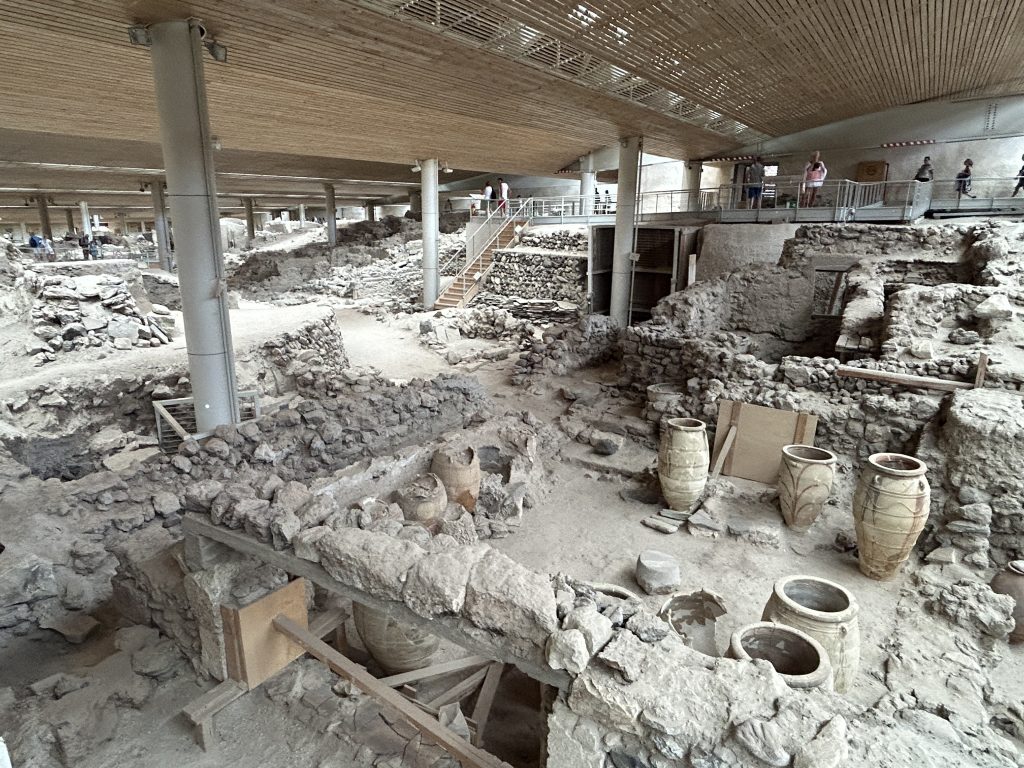
The large city (only a fraction has been excavated so far) was destroyed by a volcanic eruption in 1700 BCE (as in about 3700 hundred years ago).
Akrotiri, while impressive, is not as interesting as other sites I’ve visited, such as Pompeii. To fully appreciate it, we need to visit the Thira Archaeological Museum back in Fira.
Bus to Fira
We leave the site and see a bus marked Fira and so jump on. The two-euro-per-person fare gets us to the town in plenty of time to visit the archaeological museum and have lunch.
I’m relieved that we’ve avoided another expensive taxi ride, much as I enjoyed it.
Thira Archaeological Museum
This little gem of a museum is a must-see for visitors also wishing to visit Akrotiri—or even if not. Of the two, the museum gives a much better idea of the Minoan civilization.
The variety and sophistication of the artifacts, particularly the pottery, is astonishing.
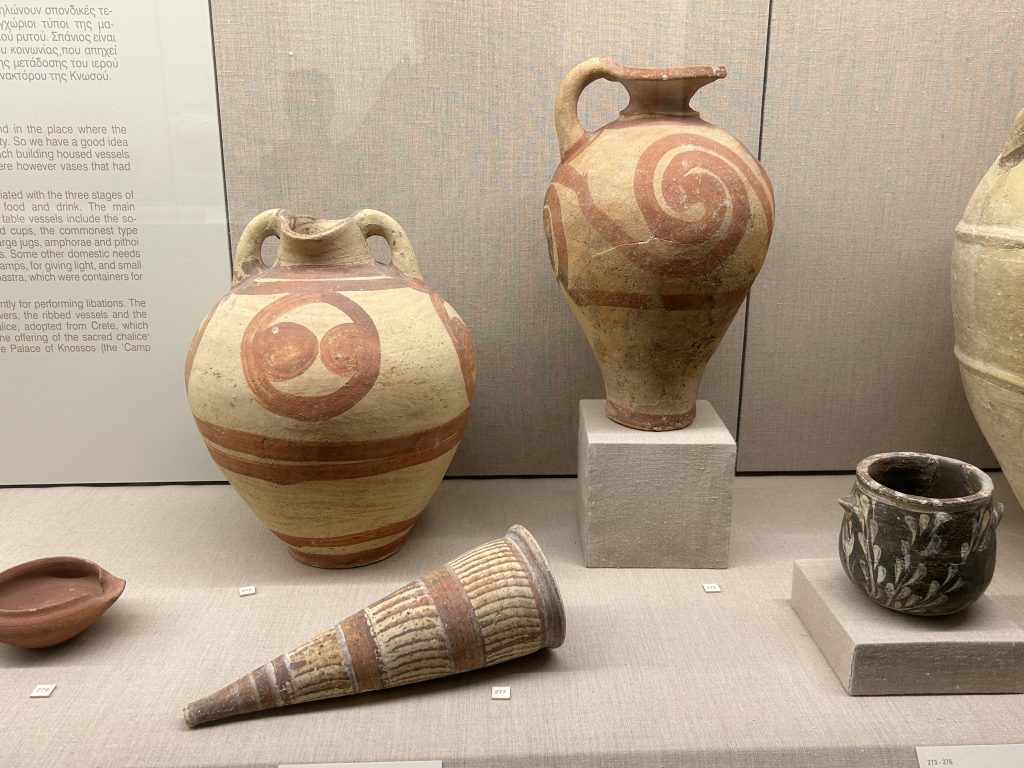
A highlight are the reconstructed frescoes depicting Minoan women, youths, palm trees, and geometric patterns. The techniques used to create the frescoes appear very similar to the techniques used in the Middle Ages.
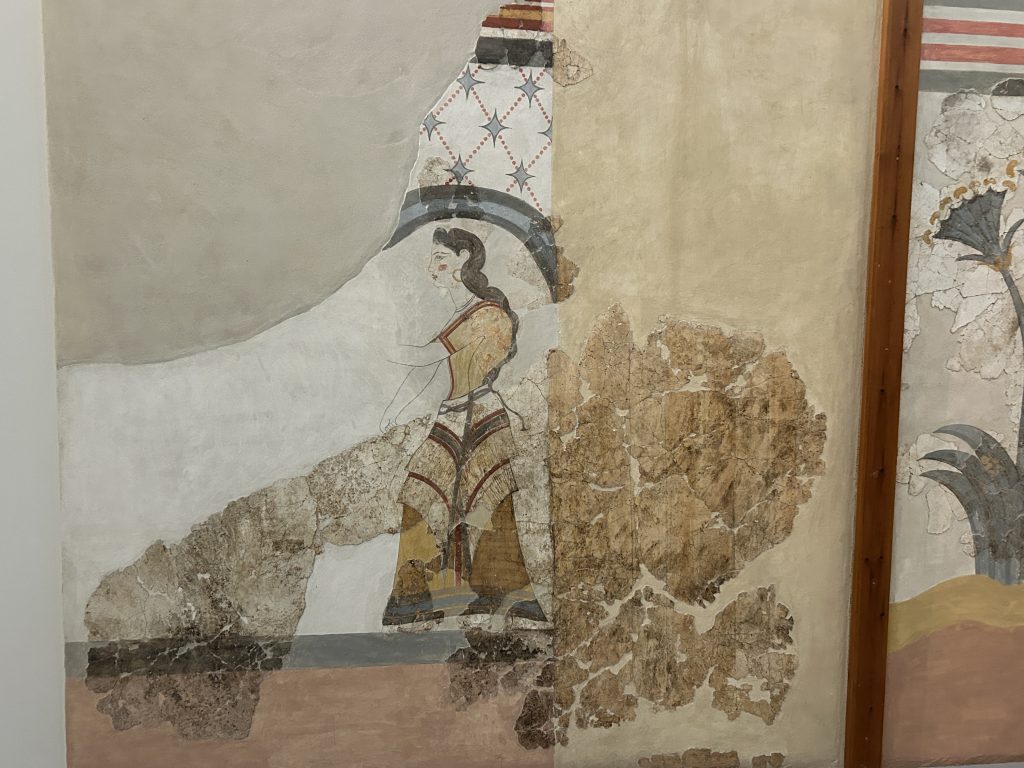
Checking Out Fira
We have plenty of time to explore Fira before we need to be down in the old harbor to embark on our five-hour boat tour.
Our first impression is that Fira is Oia on steroids–and not in a good way.
Much like Oia, the narrow, cobbled lanes are packed with souvenir stores and restaurants, but there are many, many more stores and a ton more people.
We are visiting on a day when only one large ship is in port. I’d hate to be there when there are five cruise ships as there were on our first day in Santorini when we wisely lay low.
No wonder the people of Santorini are discussing levying a day-use fee to visitors. I doubt even a 20-euro fee would deter visitors, but at least the money would help with maintaining the island’s infrastructure.
Lunch in Fira
Service is slow and indifferent, but the caldera view is stupendous and the food, as always, is fresh and tasty, particularly the very juicy red tomatoes.
Descending to the Old Port
We make our way to the cable car that will whisk us down to the old port.
We ride with two people from Toronto who are returning to their cruise ship. They are surprised that we are not also cruise passengers and impressed we’re traveling around Greece on our own.
Santorini Boat Trip
We are early for our tour, but no matter. We wait in the shade for the boat to arrive—an old wooden two-masted boat that allegedly seats 80 people.
The guide informs us that there are only 40 people on our tour which fills the boat without overcrowding. We find seats at the bow.
Julia suffers from seasickness, so she is nervous, but for most of the trip she manages, although feeling seriously peaked by the end.
Walk on Nea Kameni
Our first stop is the uninhabited island of Nea Kameni, which is an active volcano. I’ve been told that the walk to the top is a leisurely 20-minute stroll.
It is not!
I set off with all good intentions but decide to stop about a third of the way up and wait in the shade while Julia goes on ahead.
But then a very nice couple from Lyon in France asks me why I’m not going any farther. I say I’m tired, but they insist I should try.
Doucement! they say.
Go slowly.
I relent and start off up the next steep slope. At the top, I again try to stop, but they won’t hear of it.
Very kindly, they stay with me all the way to the top. I am happy I persevere. The view at the top is spectacular.
Kostas, our guide, describes what we’re seeing and reminds us that the volcano is still very much active.
It will erupt (not “may” erupt) in about 80 years, if not sooner. Who knows?
The volcano has already blown its top a few times, burying civilizations, including, possibly, Atlantis.
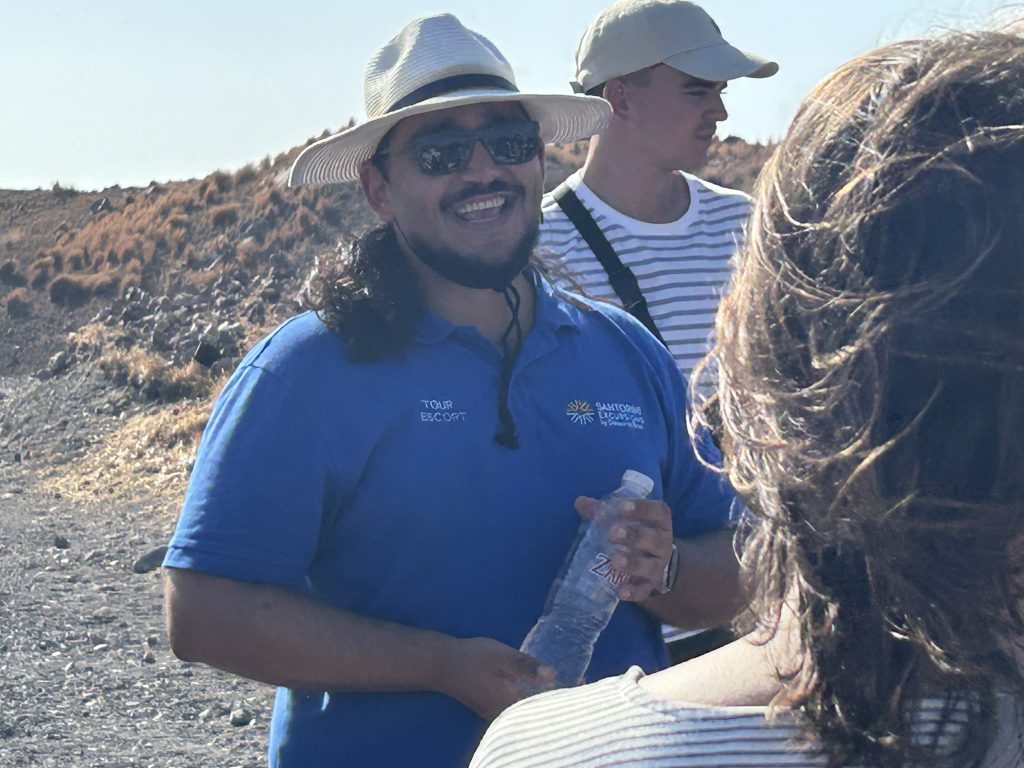
The walk back down from the volcano is not as taxing as the walk up, but it’s hot and the path is slippery.
The guide exhorts us to look down constantly to avoid nasty accidents, of which he tells us he’s seen a few.
Swimming in the Hot Springs
Back on the boat and feeling proud of myself, I get ready for the next activity—a swim in the ocean. The boat ploughs through choppy seas to the island of Palea Kameni where we anchor.
Passengers who want to swim (me included) descend the ladder into the cool sea. The temperature is about 22 degrees, which is just perfect.
The swim from the boat to the hot springs takes about ten minutes and is heavy going because the sea is choppy.
Julia opts to use a pool noodle, but I strike out on my own. As I swim, the water gets progressively warmer until it’s about 27 degrees and shallow. I’m able to stand up, which I do, and promptly seriously stub my baby toe.
Later, back at the hotel, I discover it is black and bruised. A casualty of traveling.
Stop at Therasia
Next stop after swimming is a quick visit to the island of Therasia where only about 300 people live, their principal occupation being fishing.
We dock at the bottom of a steep cliff with stairs leading up to the village at the top. At the port, there are only a handful of small taverns servicing the boat tours.
I enjoy a Sprite and watch the cats beg for food.
Feral cats freely roam here as they do in Oia and all of Santorini (and Naxos, as we discover later).
They look remarkably healthy and are very friendly, probably because they know they’ll get lots of pats and free food from all the tourists.
Sunset from the Caldera
The finale of the boat trip is a front row seat at sunset. We power over to an area where several other boats are anchored facing the setting sun.
We are each given a glass of bubbly wine and settle down to watch the sun sink slowly in the west, the way it has forever.
Kostas brings out his guitar and serenades us as the light turns golden and the cares of the world seem far away.
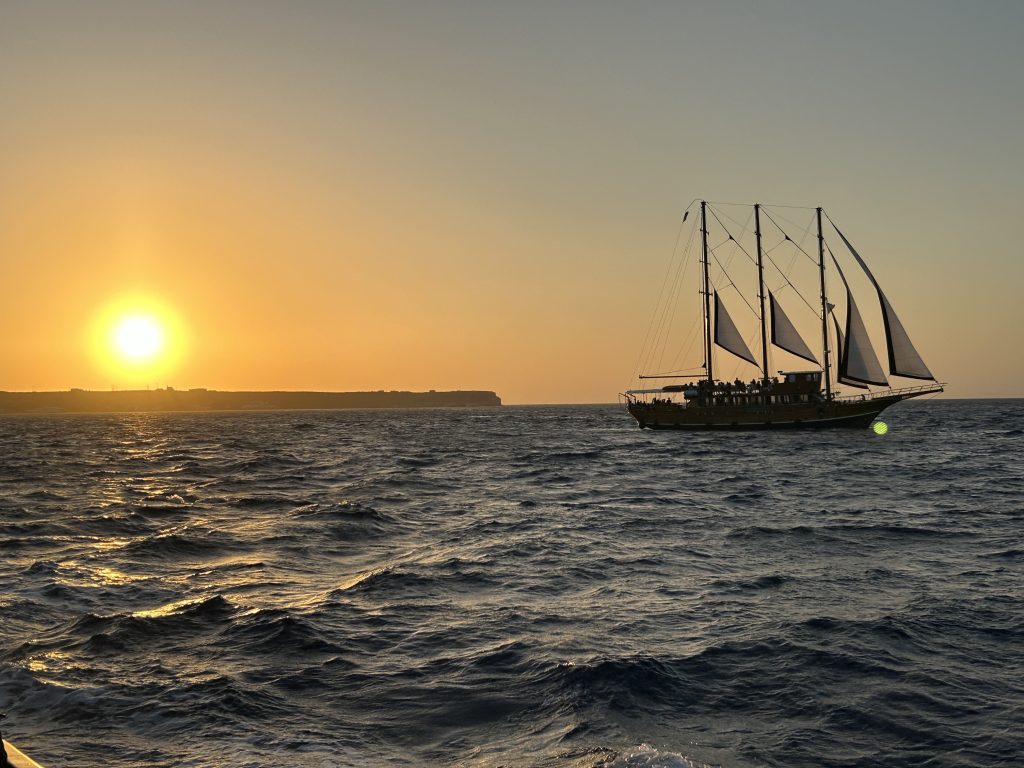
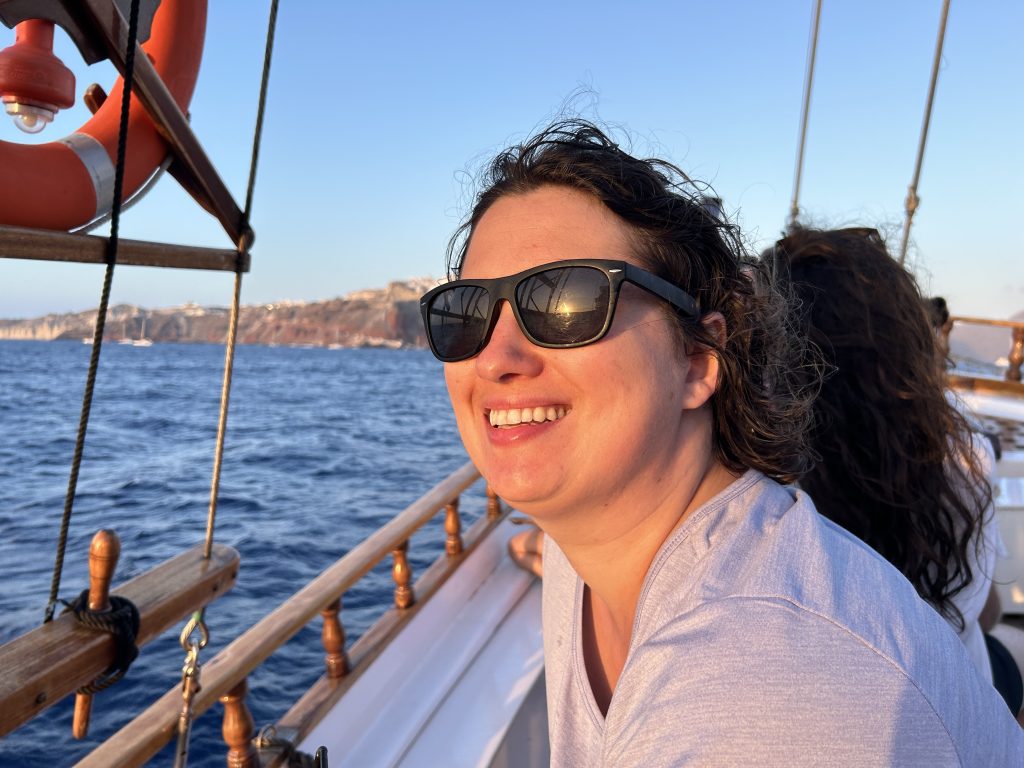
The word “magical” is used frequently to describe the Greek island experience, and truly, it is the best word.
Another word is “supernatural”, in all its many senses.
I feel the presence of ancient Minoans who sailed these very seas, of Greeks heading for Troy, of pirates and Crusaders and finally tour boats.
These seas have witnessed millennia of human activity.
These seas have been here forever.
Options for Sailing Tours
I recommend the sunset sailing tour. You can book all-day catamaran tours that include meals, but the waters around Santorini can get rough and if you’re prone to seasickness, I’d recommend going for one of the shorter tours.
You’ll share the experience with more people, but the sunset still looks amazing!
Here’s the tour we took:
My Recommendations for Enjoying Santorini
First off, should you visit Santorini? It’s crowded, touristy, and a bit crass.
It’s also amazingly, spectacularly beautiful and one of the principal tourist destinations in Greece.
So yes, I recommend you make a visit to Santorini at least once.
Stay in Oia Rather than Fira
A friend back in Canada told me we had to change our reservation from Fira to Oia, and we are very glad we took her advice.
While Oia requires a bit more effort to reach, it’s well worth it.
Oia really is Santorini’s most gorgeous location, which is saying something because just about every location along the edge of the caldera affords magnificent views.
But Oia also has the blue-domed churches clustered in photogenic spots, is a very walkable town, and boasts friendlier servers (at least in our experience).
Oia also offers a more upscale atmosphere, and is also very popular with honeymooners. Prepare to see a lot of cuddling couples, some dressed in their wedding gear and getting their picture taken at sunrise and/or sunrise.
Hike From Oia to Fira
If you’re feeling energetic (and I confess I was not), you can hike from Oia to Fira, or the other way round.
You’ll pass through the little village of Imerovigli, and enjoy jaw-dropping views along the way. If it’s hot, go very early in the morning.
The 10 km hike takes about 2.5 hours, although that time will probably be much higher since you’ll be stopping every ten feet to snap yet another photo.
Comparing Service between Oia and Fira
We notice a distinct difference in service between Oia and Fira, which must absorb all the cruise ship passengers every day.
In Fira, our food and drinks are pretty much thrown at us and smiles are thin on the ground. On the other hand, the food is tasty.
Although still crowded, Oia is smaller, more intimate, and less frantic than its bigger sister.
There are also plenty of excellent options for eating in Oia, and the goods in the shops are of higher quality with fewer shops devoted exclusively to selling schlock.
I enjoyed a long conversation with a guy in a jewelry shop as he packaged up the pendant I bought. He was in no hurry to rush me out, and was happy to answer my questions about living on Santorini.
In Fira, the shopkeepers just looked kind of tired.
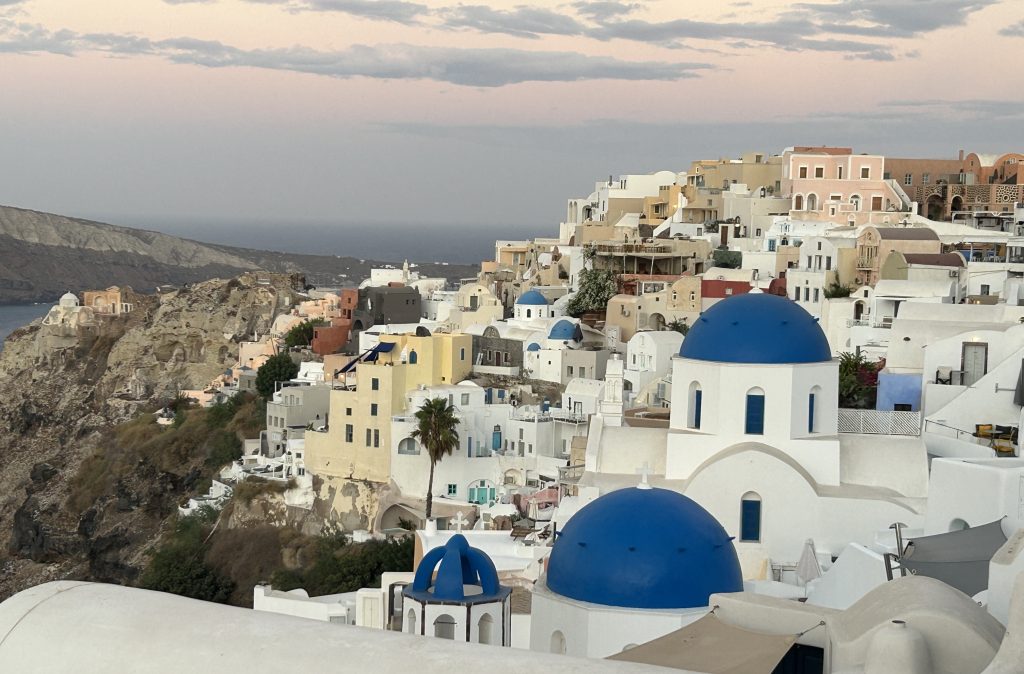
Sunsets at Oia
Oia is famous for its sunsets, with people coming from all over the island to jockey for position. It’s a bit off-putting to watch people pushing and shoving, cell phones held aloft.
The best way to see a sunset is to reserve a table at a restaurant that faces the sunset, as we did on our first night.
If you don’t do that, this is what you may see.
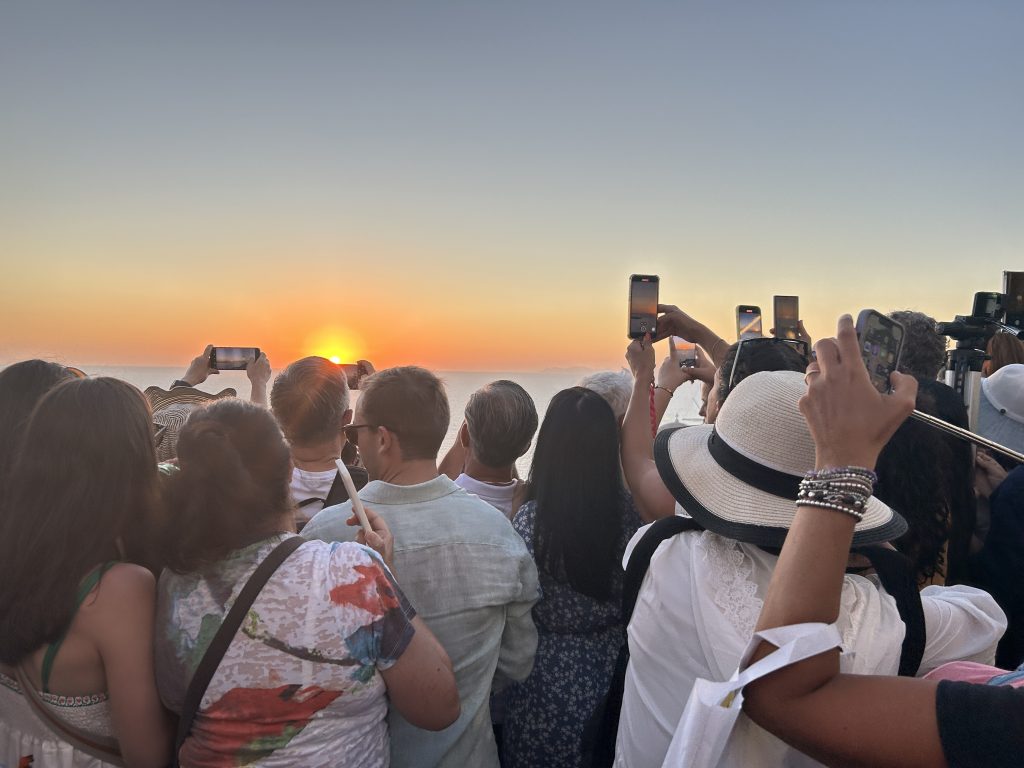
Another Reason to Stay in Oia
In the evening after the boat trip and dinner, we catch the bus from Fira back to Oia and sit right at the front.
The roller coaster ride in the dark with sheer drops to our right as the bus driver skillfully coaxes his massive bus around numerous switchbacks takes a few years off my life.
But when we arrive at Oia, we see a massive lineup of people waiting to catch the bus back to Fira after watching the sunset in Oia.
There is no way they will all fit on the bus which means many will be waiting an hour for the next bus—and it’s already 10 pm. This bottleneck after sunset is reason enough to make Oia your home base.
Also, staying in Oia means more opportunities to take night shots like this.
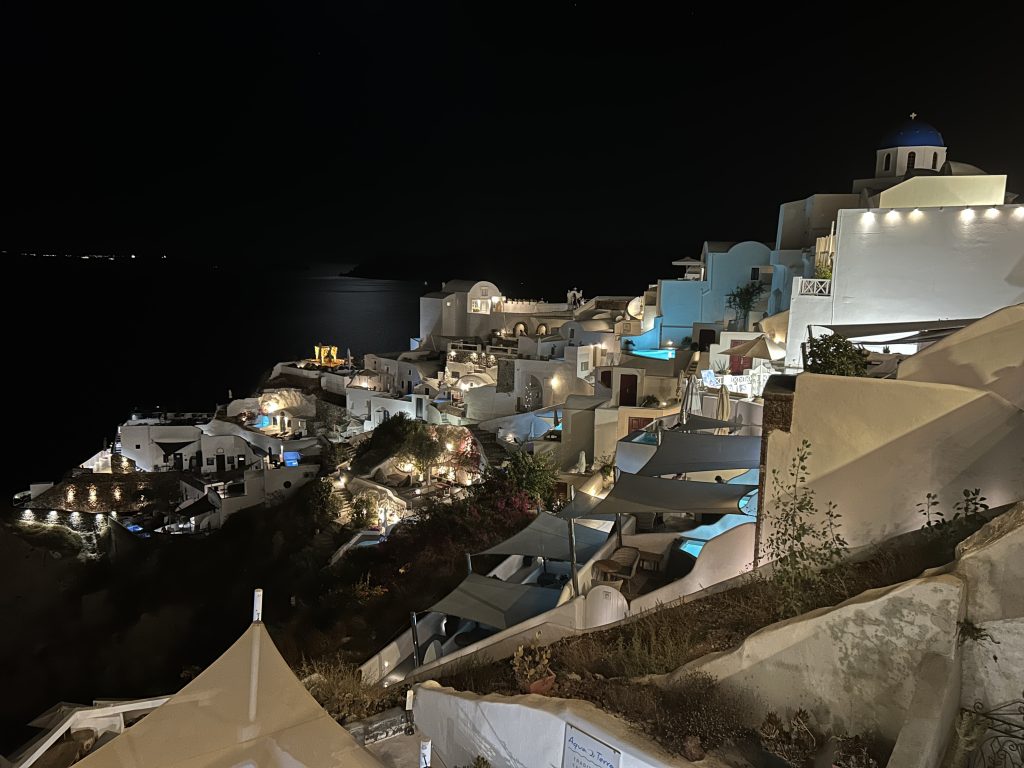
Sunrises in Oia
For us, one of the many highlights of staying in Oia instead of staying in Fira is the opportunity to witness the sunrise.
On our last morning, we get up at 6:30 and station ourselves at a viewpoint that during the day and especially at sunset is clogged with tourists. We are virtually alone as we wait for the sun to rise over the blue domes.
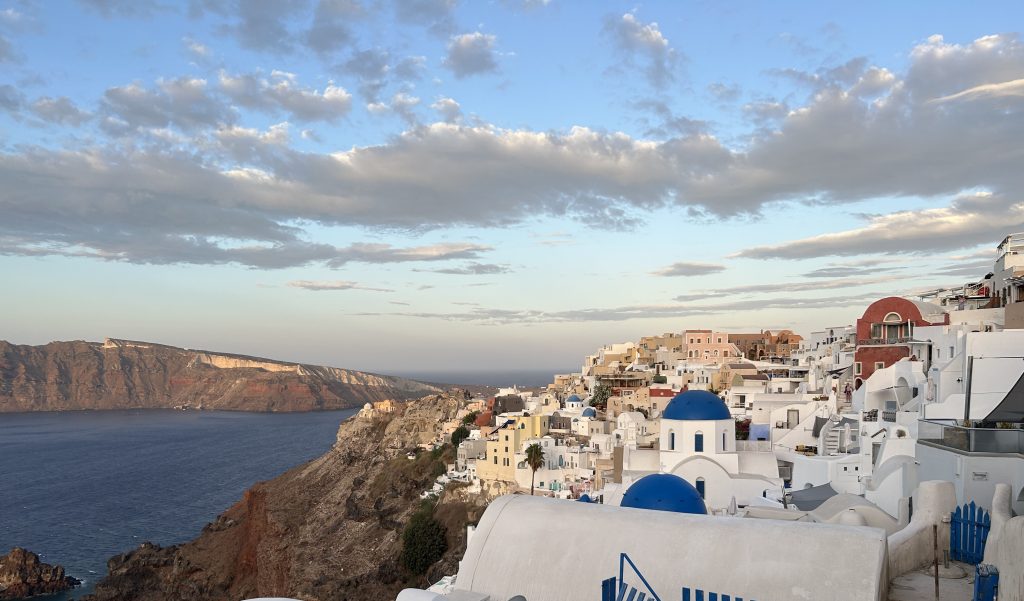
The air is still and warm and a slight wind ruffles the cascades of bougainvillea and carries the sounds of twittering birds.
I look past the jumble of whitewashed buildings and the turquoise rectangles of private pools on private terraces of places that cost a small fortune to stay in, and fix my gaze on a view that has enchanted people for millennia.
Conclusion
Stay at least three nights—preferably four or five— in Oia to fully explore the island, and to experience Oia at all times of the day, from the crazy crowds at sunset to the quiet afternoons to the pearly dawns.
While accommodation bargains can be had by staying on the opposite side of Santorini from the caldera, I wouldn’t bother.
Splurge and stay in Oia and then visit another less touristy island for a more Greek experience.
Santorini can be reached by plane or ferry. We arrived by plane and left by ferry to visit the island of Naxos—another highly recommended Greek island.
Have you visited Santorini? Share your comments and suggestions in the comments below.
Other Artsy Traveler Posts About Greece
- How to Spend Two Laid-Back, Glorious Days on the Greek Island of Naxos
- Nine Great Reasons To Visit Meteora in Greece
- How to Spend a Perfect Artsy Traveler Day in Athens
- Explore Greek Cuisine in a Savor Nafplio Cooking Class
- How To Spend Two Wonderful Days in Charming Nafplio in Greece
- Should You Make the Climb to the Acropolis of Athens
